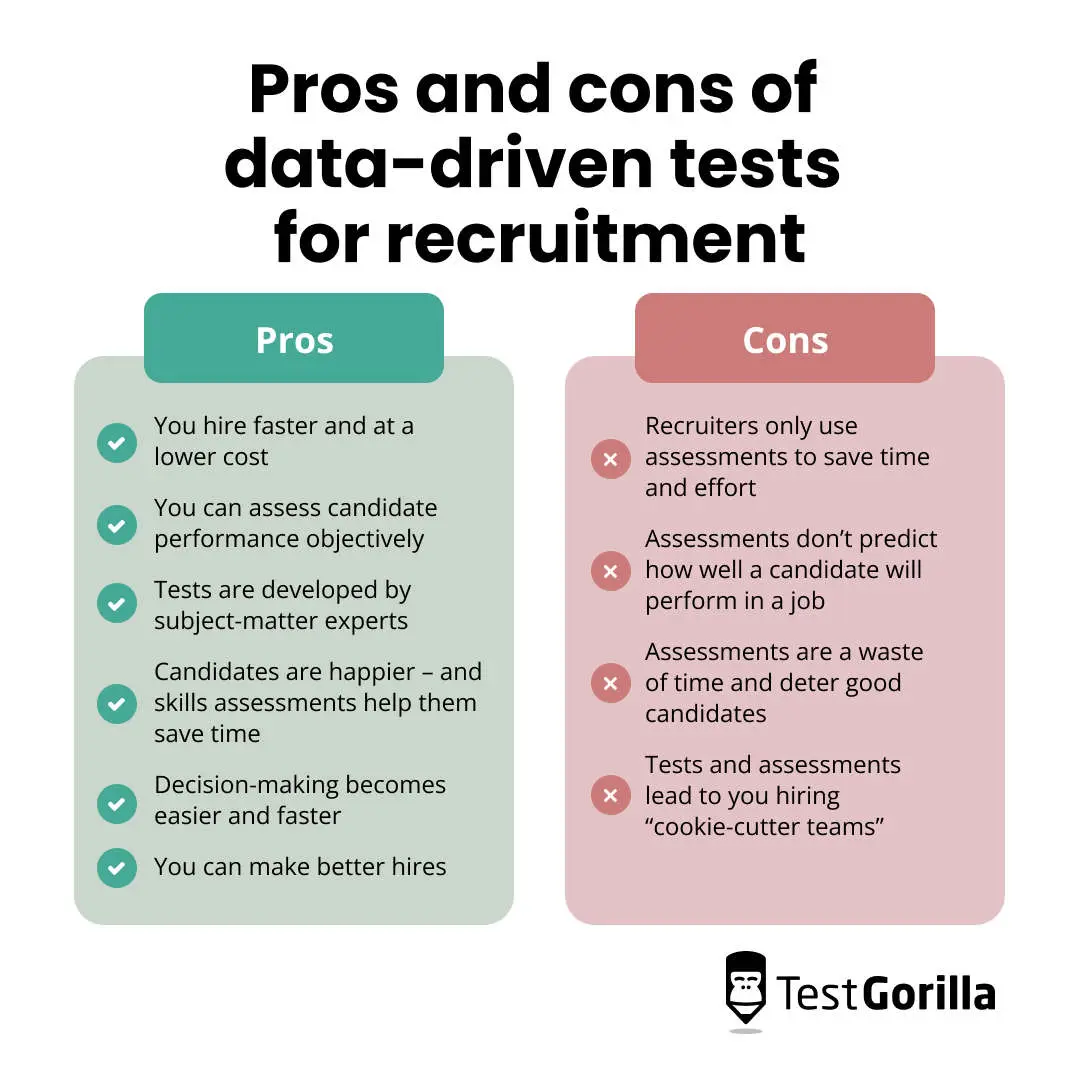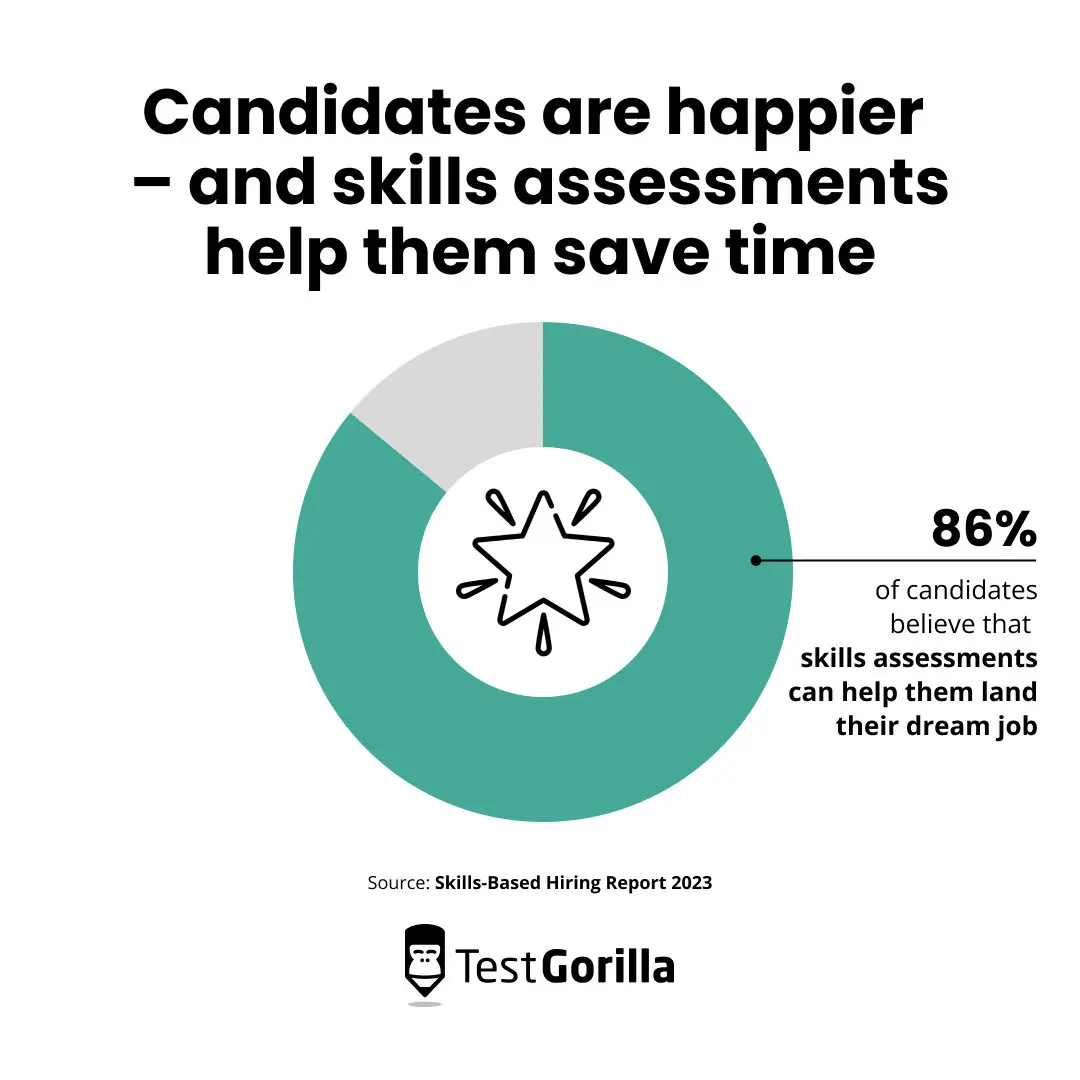Picture a recruiter’s nightmare.
Your team is trying to fill three different vacancies, and you’re snowed under with resumes. You’re trying to pick out a shortlist from a pile of “detail-oriented” and “motivated” candidates, but all it’s doing is giving you a stress headache.
Meanwhile, an ex-colleague on LinkedIn is glowing like they’ve just stepped off a plane from Aruba. They’re trying to fill five vacancies, but they’re not worried – they’re using psychometric testing to screen candidates. No piles of CVs for them!
“Some people cut corners,” you grumble to yourself. You know you’re better than that. You’re not lazy.
Surely job assessments are a waste of time, right?
But still, you feel some doubt. Could your ex-colleague be onto something? Are recruiters who use assessments lazy, or is data-driven recruitment the way forward? Could job assessments be actually effective?
In this blog post, we’ll weigh both sides of the debate – but first, let’s clarify what “data-driven recruitment” means.
Table of contents
- What are screening tests and job assessments?
- The debate: Are job assessments a waste of time?
- Are job assessments for tech-savvy recruiters who want to save time? The pros of job assessments
- Are job assessments a waste of time? The cons and potential concerns
- The final verdict: Job assessments are part of a balanced and fair approach that helps save everyone’s time
What are screening tests and job assessments?
Pre-employment skills testing is a key part of data-driven recruitment. It refers to online pre-employment exams, which recruiters usually use in place of the traditional first round of screening resumes and cover letters.
There are many types of pre-employment assessments out there, testing everything from Python coding ability to emotional intelligence.
However, all types of effective pre-employment tests have some things in common:
They collect the same data for all candidates
They provide objective measures with which to compare candidates
They help you look into the core competencies of the role you’re hiring for
We’ll talk more about the specifics of pre-employment testing throughout this post. Now it’s time to get to the debate.
The debate: Are job assessments a waste of time?
The debate about pre-interview testing is a hot one in HR circles. It usually centers on whether data-driven recruitment requires ditching all traditional methods and the benefits they bring to your hiring strategy – or whether it’s a waste of time (yours and your candidates’).
For instance, some professionals think that assessments focus too much on hard data and not enough on the human qualities that make candidates a good fit – and that this makes them bad for workplace diversity. They also aren’t convinced that skills assessments are a valuable use of the time and resources of hiring teams.
Others believe the opposite. They say that pre-employment testing helps you overcome biases and see candidates clearly for not just who they are, but also for their potential – and that they speed up recruitment and help reduce the time to hire.
In this post, we’ll explore the arguments for both of these positions and give our verdict on whether job assessments are a waste of your and your candidates’ time – or whether, on the contrary, they make hiring easier for everyone.
We believe in transparency, so before we start, let us be clear about our position. TestGorilla is a skills-testing platform. We believe in the power of skills-based testing to deliver the right hire.
But although we have skin in the game, we care most about giving you all the information you need to make an informed decision.
If you’re in a rush, why not skip straight to the head-to-head comparison table or the final verdict?
Are job assessments for tech-savvy recruiters who want to save time? The pros of job assessments
Let’s start with the things that attract recruiters to pre-employment testing in the first place.
Here are six benefits of data-driven recruiting using tests and our insights into whether they’re proven or questionable.
1. You hire faster and at a lower cost
The age of the CV as the first port of call for hiring is coming to an end.
Back in the 1980s and 1990s, businesses hired by selecting applicants who delivered hard-copy resumes to the appropriate hiring manager to review manually. It took a while, but there were only a few applications, so it was manageable.
Back then, looking at the few resumes you received from local applicants certainly didn’t seem like a waste of time – and it was easy to pick the best ones to invite to an interview.
Fast-forward to the present day. Candidates have far more ways to reach you – and vice versa. This means you have access to a wider talent pool, but it also means more work for you.
Corporate positions often attract dozens or even hundreds of applicants. Screening hundreds of resumes takes a lot of time. And, in hiring, time is money.
Research has shown that a single vacancy costs a company an average of around $123 per day, adding up to a staggering $4,425 over the average of 36 days it takes to fill it.
This contributes to the high average cost per hire, which the same research found is more than $14,000 for executive hires. This includes things like:
Fees for posting vacancies on job boards
Advertising costs
Recruitment agency fees
Internal fees, including your and your team’s salaries
By contrast, sending every applicant an in-depth standardized assessment enables you to easily compare and filter out unqualified candidates based on their actual skills and values, not just what they claim in their resumes.
It’s a win-win situation. You get what you need faster and at a lower cost to your employer.
Our verdict: Proven benefit – skills testing enables you to hire faster.
In fact, not using job assessments is a waste of time, as it forces you to rely on traditional hiring methods, which are much more resource-intensive (manually screening resumes and interviewing candidates) or less objective (automated resume processing).
2. You can assess candidate performance objectively
When you use pre-employment assessments, you’re evaluating candidates based on their skills and not just what they say in their resumes. Research has shown that many candidates are perfectly comfortable bending the truth in their resumes.
Furthermore, candidates are not always the best judges of what’s most relevant to a role. We all know it sometimes takes a few minutes of digging to find the most important information in a badly written resume.
Skills tests are not only better predictive tools (more on this below) but also more inclusive ones.
In addition to recruiters’ unconscious biases, many common resume “best practices” touted by recruitment professionals also discriminate against certain groups, as shown in the table below:
Resume “red flags” | Groups this affects negatively |
Large gaps between roles | People with illnesses or disabilities that have hindered their ability to work; Parents and carers with childcare responsibilities returning to the workforce, who are more likely to be women |
Frequent changing of roles (known as “job hopping”) | People with responsibilities that have forced them to move |
Poor spelling and/or grammar | People whose first language isn’t English; People with learning disabilities such as dyslexia |
These “red flags” are supposed to help you save time by not interviewing unsuitable – but actually, they eliminate candidates who might be perfectly fit for the job. In other words, they slow down recruitment.
By contrast, pre-employment assessments help you compare candidates anonymously based on competency. You can also make special accommodations so that all applicants have equal access. That means less bias and more opportunities for candidates to show their skills – which, in turn, enables you to find the right person faster.
The long-term effects of objectively assessing candidates are huge: Hiring managers who use assessments rate their hires as “above average” or “excellent.”
Our verdict: Proven benefit – job assessments help you make more objective decisions.
3. Tests are developed by subject-matter experts
Even the most plugged-in recruiter has gaps in their knowledge of the role they’re hiring for. For example, you might not know the specific coding experience candidates require or whether having experience as the head of product at a SaaS company is relevant for the role of chief executive officer of a media startup.
If you use a traditional approach in such cases, you might let great talent slip away. Pre-employment testing can remedy this.
All of TestGorilla’s tests are created by subject-matter experts (SMEs) who have an in-depth understanding of the practical competencies required for specific roles. They also have the knowledge and experience needed to create relevant and up-to-date test questions that keep up with industry changes.
For example, Jessie, an SME with extensive experience as an environmental consultant and an MSc in Chemistry, authored our Working with Data test. She applied her scientific skills to create questions about data visualizations, scientific writing, and GIS analysis and mapping. Now that’s someone you can trust to ask the right questions.
Our verdict: Proven benefit – reputable skills assessment platforms turn to subject-matter experts for the development of their tests.
4. Candidates are happier – and skills assessments help them save time
Providing a great candidate experience is one of the best ways to improve overall employee satisfaction and retention. One way you can do this is by keeping the initial application process as short and simple as possible.
We know what you’re thinking: How does a job assessment achieve that? The candidate has barely interacted with your company, and you’re asking them to invest their precious time in an online assessment, which you then need to check. A total waste of time, right?
However, there is another way to think of this. Candidates might take hours tailoring their resumes and writing cover letters when applying to your organization.
In addition to using their preparation time more efficiently, candidates benefit from pre-employment assessments in the following ways:
They’re not dragged through rounds of interviews before finding out they’re not a good fit
They know they will definitely be considered (in other words, their CVs won’t end up being discarded without a response)
They know that the assessment is objective
To provide a good candidate experience, make sure to:
Assess skills that are relevant to the role – and not just any skill that feels remotely related
Give applicants enough context by explaining why you’re asking them to take a job assessment
Say how much time the assessment will take to complete
Keep candidates updated on their progress
This way, candidates won’t hate you for asking them to take a job assessment or think skills tests are a total waste of time; instead, they’ll see them for what they are: a recruitment tool designed to minimize bias and place skills in the center of hiring decisions.
Our verdict: Proven benefit – in fact, 86% of candidates believe that skills assessments can help them land their dream job, according to our data.
5. Decision-making becomes easier and faster
The shift toward skills-based hiring (as opposed to hiring based on degrees or interview results alone) makes hiring decisions much easier.
It requires you to identify the key skills necessary to do the job at the outset and then assess those skills in a controlled environment. For example, you could give potential leaders situational judgment tests or have programmers complete a coding exercise.
This makes it easy to shortlist candidates for interviews because you can compare all the applicants’ performance on one dashboard.
Skills-based hiring can also support your decision-making during and after the interview stage. Test results give you an initial idea of candidates’ skills. You can then use structured interviews with your best talent to gain deeper insights, referring back to the test results when it’s time to make a final decision, thus streamlining the entire process.
Our verdict: Proven benefit – decision making becomes faster, easier, and more objective with skills tests.
6. You can make better hires
Finally – and most importantly – assessments are better than almost any other measure at predicting performance.
According to a meta analysis by Frank Schmidt and John Hunter, general mental ability assessments combined with work samples are a more reliable predictor than a candidate’s work experience, references, and interview performance.
How can you replicate this in your hiring process? By using cognitive ability tests and role-specific tests in tandem.
You automatically improve the efficiency of your hiring process and raise the bar for the final hire by giving all applicants the same level of access and attention. This also ensures that everyone who makes it to the interview stage has the minimum required skills and the right values for the role.
Our verdict: Proven benefit – making better hiring decisions helps you save a tremendous amount of time (and money) in the long run.
Are job assessments a waste of time? The cons and potential concerns
With so much data supporting the adoption of skills tests in the hiring process, sticking to CVs and application forms might seem so 20th century. But why do many recruiters still spurn pre-employment testing as part of a data-driven recruitment approach?
Here are four concerns we hear recruiters raise about pre-interview assessments:
1. Recruiters only use assessments to save time and effort
There’s no denying there’s something just a little bit arrogant about the phrase “work smarter, not harder.” After all, if you’re an ambitious professional, you’re probably not afraid of a little elbow grease, right?
But, as we’ve seen above, using a more efficient screening tool saves you time, effort, and considerable amounts of money. As an in-house HR rep, you can reinvest these resources into activities like:
Improving your onboarding process
Designing employee wellness programs
Creating hiring plans for future growth
But saving time is only part of the equation and not the main reason you should use assessments. Skills assessments are strongest when paired with a thorough background check and a clear interviewing strategy.
They’re there to help you get more value from your time by freeing up space for the activities you were hired to do. However, if cutting corners is your goal, this isn’t the strategy for you.
It’s still important to take the time to select the right skills tests for your open role when building an assessment. You’ll also still need to carefully structure the interview phase of the hiring process and ask interview questions that will give you an accurate sense of candidates’ relevant skills.
Our verdict: Valid concern – some employers might use skills tests simply to save time.
2. Assessments don’t predict how well a candidate will perform in a job
If you’re not familiar with skills testing, it probably sounds like a glorified version of those personality quizzes you took online as a teenager, such as “Which pizza topping are you?” or “Which member of the Friends cast would be your bestie?”But in reality, assessments aren’t – and aren’t supposed to be – personality quizzes or logic puzzles that don’t relate to the job. If they were, then yes, they’d be a waste of everyone’s time.
In fact, our tests cover core competency areas, including:
Language skills
Technical requirements, e.g., programming skills
Situational judgment (i.e. how candidates would act in a given scenario)
However, there are valid concerns about hiring managers relying excessively on testing. For example, a candidate could ace their assessment but fail in the job because the hiring manager didn’t check if they were aligned with the company in terms of values and culture.
Alternatively, you might reject a candidate because they had somewhat poor results on one of their tests, maybe due to performance anxiety, even though they aced their interviews.
These are valid drawbacks. That’s why at TestGorilla, we never advocate using testing as your sole recruiting tool.
Instead, we recommend a holistic approach that includes conducting structured interviews to give your hiring process that much-needed human touch.
This enables you to assess all candidates fairly. For example, Harvard Business Review recommends assessing so-called “imperfect” candidates by:
Measuring their capacity for learning
Looking for the hallmarks of potential, such as curiosity, engagement, and motivation
Offering multiple assessments
Verdict: Valid concern – skills tests aren’t meant to be used in a vacuum or as a standalone skills evaluation tool.
3. Assessments are a waste of time and deter good candidates
Automating the hiring process can be a time-saver. Still, it may come at a cost, giving candidates the impression that your business is hands-off and disrespectful of their application efforts.
Many recruiters worry that having candidates complete pre-employment assessments seems like a big ask, particularly if it’s their first point of contact with the company. After all, you’re asking them to commit their time to work on these tests before they’ve even met with you.
The best way to show candidates that you won’t waste their time is by using those two strategies:
Clear communication
Using the appropriate tests for each role
Make sure you clearly communicate the purpose of the tests, using strong personalization methods and a human touch whenever possible.
For example, with TestGorilla, you can record a video from the hiring manager or a relevant team member and display it at the start of each job assessment, thanking the candidate for their time and explaining the purpose of the tests.
Finally, make it clear to the candidates that you’re using the tests to overcome biases and ensure they get the visibility and feedback they deserve throughout the hiring process.
Our verdict: Valid concern – if you use a highly impersonal, hands-off approach to testing, candidates might feel like you don’t value their time and efforts. It’s up to you to show them that you do.
4. Tests and assessments lead to you hiring “cookie-cutter teams”
Skills tests can only take you so far. You also need to hire someone who will help serve and grow your company culture, which is much trickier and more subjective than hiring someone based on skills like programming or language expertise.
This can be an area where data-driven recruiters trip up with pre-interview assessments. This usually happens because they hire for “culture fit” instead of “culture add.”
Briefly, “culture fit” refers to when a candidate matches the superficial personality types present in your existing team. They might be fun around the office, but they won’t push your team to think in new ways. Testing can support this kind of hiring if you use it to identify candidates who are similar to your existing team.
However, this pitfall isn’t unique to data-driven hiring. In fact, it’s usually the default approach of most traditional recruitment methods. This is known as similarity bias: Hiring managers and team leads might have an unconscious preference for people who are similar to them – and prioritize them when making hiring decisions.
On the other hand, hiring for “culture add” identifies cultural matches for your organization through shared values. Testing supports this by eliminating human bias at the shortlisting stage.
You’ll likely end up with all sorts of personality types on your team, all supporting each other toward their common goals, as we do at TestGorilla.
Our customizable Culture Add test can help you hire culturally diverse teams.
Our verdict: Confirmed drawback, if you hire for culture fit instead of culture add.
The final verdict: Job assessments are part of a balanced and fair approach that helps save everyone’s time
Overall, data-driven recruitment tools are what you make of them.
They are undoubtedly faster and more efficient than skimming through a huge pile of cover letters. Job assessments are also likely to provide more information on candidates’ role-specific competencies than an initial appraisal by a hiring manager.
They have a clear track record of eliminating bias in recruitment, and you can incorporate them as part of a strong, agile recruitment strategy.
However, the power and insight that data-driven recruitment tools give you come with a caveat.
You will still see mixed results unless you reinvest the time you save into higher-value areas of the recruitment process and use skills assessments alongside other tools, including structured interviews and thorough reference checks.
So, your ex-colleague might have a point after all.
In fact, now that you know how powerful job assessment tools can be, you can already see how much time they might save you when used by someone with your experience.
And they also save candidates’ time by not dragging them through endless interviews for roles that aren’t a good fit for them. Win-win, right?
Sign up for a free live demo to find out how to leverage job assessments in your recruitment process to make it faster and more objective – or try out our platform for free.
Related posts
Hire the best candidates with TestGorilla
Create pre-employment assessments in minutes to screen candidates, save time, and hire the best talent.
Latest posts
The best advice in pre-employment testing, in your inbox.
No spam. Unsubscribe at any time.

Hire the best. No bias. No stress.
Our screening tests identify the best candidates and make your hiring decisions faster, easier, and bias-free.
Free resources
This checklist covers key features you should look for when choosing a skills testing platform
This resource will help you develop an onboarding checklist for new hires.
How to assess your candidates' attention to detail.
Learn how to get human resources certified through HRCI or SHRM.
Learn how you can improve the level of talent at your company.
Learn how CapitalT reduced hiring bias with online skills assessments.
Learn how to make the resume process more efficient and more effective.
Improve your hiring strategy with these 7 critical recruitment metrics.
Learn how Sukhi decreased time spent reviewing resumes by 83%!
Hire more efficiently with these hacks that 99% of recruiters aren't using.
Make a business case for diversity and inclusion initiatives with this data.



















